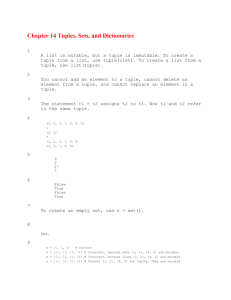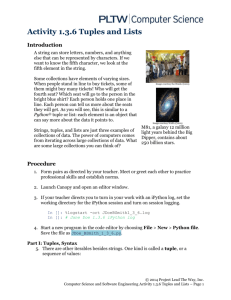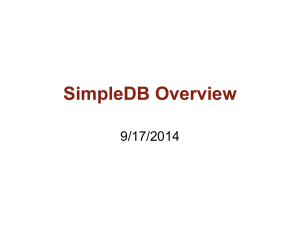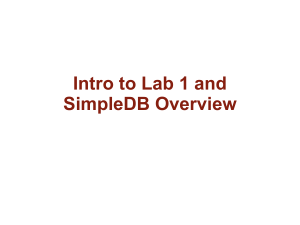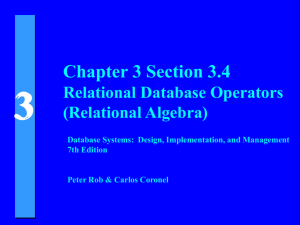pptx - Chair of Software Engineering
advertisement
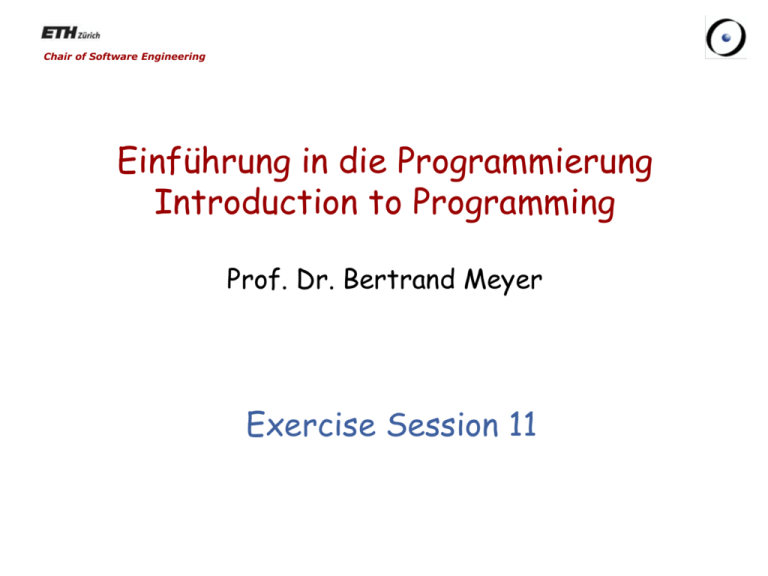
Chair of Software Engineering Einführung in die Programmierung Introduction to Programming Prof. Dr. Bertrand Meyer Exercise Session 11 News Mock exam in one week (December 6th, 7th) You have to be present The week after (last exercise session) we will discuss the results 2 Today Basic Data-structures Arrays Linked Lists Hashtables Tuples Agents Agents and Data-structures 3 Arrays An array is a very fundamental data-structure, which is very close to how your computer organizes its memory. An array is characterized by: Constant time for random reads Constant time for random writes Costly to resize (including inserting elements in the middle of the array) Must be indexed by an integer Generally very space efficient In Eiffel the basic array class is generic, ARRAY [G]. 4 Using Arrays Which of the following lines are valid? Which can fail, and why? my_array : ARRAY [STRING] my_array [“Fred”] := “Sam” my_array [10] + “’s Hat” my_array [5] := “Ed” my_array.force (“Constantine”, 9) Valid, can’t fail Invalid Valid, can fail Valid, can fail Valid, can’t fail Which is not a constant-time array operation? 5 Linked Lists Linked lists are one of the simplest data-structures They consist of linkable cells class LINKABLE [G] create set_value feature set_value (v : G) do value := v end set_next (n : LINKABLE[G]) do next := n end next : LINKABLE [G] end value : G 6 Using Linked Lists Supposing you keep a reference to only the head of the linked list, what is the running time (using big O notation) to: Insert at the beginning Insert in the middle Insert at the end Find the length of the list O (1) O (n) O (n) O (n) What simple optimization could be made to make endaccess faster? 7 Hashtables Hashtables provide a way to use regular objects as keys (sort of like how we use INTEGER “keys” in arrays). This is essentially a trade-off: we have to provide a hashing function hashing function should be good (minimize collision) our hashtable will always take up more space than it needs to 8 Good points about Hashtables Hashtables aren’t all that bad though, they provide us with a great solution: they can store and retrieve objects quickly by key! This is a very common operation. For each list define, what the key and values could be: A telephone book Name Telephone Number The index of a book Concept Page Google search Search String Websites Would you use a hashtable or an array for storing the pages of a book? 9 Tuples A tuple of type TUPLE [A, B, C] is a sequence of at least three values, first of type A, second of type B, third of type C. In this case possible tuple values that conform are: [a, b, c], [a, b, c, x],... where a is of type A, b of type B, c of type C and x of some type X Tuple types (for any types A, B, C, ... ): TUPLE TUPLE [A] TUPLE [A, B] TUPLE [A, B, C] ... 10 Labeled Tuples Tuples may be declared with labeled arguments: tuple: TUPLE [food: STRING; quantity: INTEGER] Same as an unlabeled tuple: TUPLE [STRING, INTEGER] but provides easier (and safer!) access to its elements: May use io.print (tuple.food) instead of io.print (tuple.item(1)) 11 Tuple Inheritance TUPLE TUPLE [A] TUPLE [A,B] ... 12 Tuple conformance tuple_conformance local t0: TUPLE t2: TUPLE [INTEGER, INTEGER] do Not necessary in this case create t2 t2 := [10, 20] Implicit creation t0 := t2 print (t0.item (1).out + "%N") Runtime error, but print (t0.item (3).out) will compile end 13 What are agents in Eiffel? Objects that represent operations Can be seen as operation wrappers Similar to delegates in C# anonymous inner classes in Java < 7 closures in Java 7 function pointers in C functors in C++ 14 Agent definition Every agent has an associated routine, which the agent wraps and is able to invoke To get an agent, use the agent keyword e.g. an_agent := agent my_routine This is called agent definition What’s the type of an_agent? 15 EiffelBase classes representing agents call + PROCEDURE * ROUTINE + FUNCTION item + PREDICATE 16 Agent Type Declarations p: PROCEDURE [ANY, TUPLE] Agent representing a procedure belonging to a class that conforms to ANY. At least 0 open arguments q: PROCEDURE [C, TUPLE [X, Y, Z]] Agent representing a procedure belonging to a class that conforms to C. At least 3 open arguments f: FUNCTION [ANY, TUPLE [X, Y], RES] Agent representing a function belonging to a class that conforms to ANY. At least 2 open arguments, result of type RES 17 Open and closed agent arguments An agent can have both “closed” and “open” arguments: closed arguments are set at agent definition time open arguments are set at agent call time. To keep an argument open, replace it by a question mark u := agent a0.f (a1, a2, a3) -- All closed w := agent a0.f (a1, a2, ?) x := agent a0.f (a1, ?, a3) y := agent a0.f (a1, ?, ?) z := agent a0.f (?, ?, ?) -- All open 18 Agent Calls An agent invokes its routine using the feature “call” f (x1: T1; x2: T2; x3: T3) -- defined in class C with -- a0: C; a1: T1; a2: T2; a3: T3 u := agent a0.f (a1, a2, a3) v := agent a0.f (a1, a2, ?) w := agent a0.f (a1, ?, a3) x := agent a0.f (a1, ?, ?) y := agent a0.f (?, ?, ?) u.call ([]) [C, TUPLE] PROCEDURE v.call ([a3])[C, TUPLE [T3]] PROCEDURE w.call ([a2]) PROCEDURE [C, TUPLE [T2]] x.call ([a2, [C, a3]) PROCEDURE TUPLE [T2, T3]] y.call ([a1, [C, a2,TUPLE a3]) [T1,T2,T3] PROCEDURE What are the types of the agents? 19 Doing something to a list Given a simple ARRAY [G] class, with only the features `count’ and `at’, implement a feature which will take an agent and perform it on every element of the array. do_all (do_this : PROCEDURE[ANY, TUPLE[G]]) local i : INTEGER do from i := 1 until i > count loop do_this.call ([at (i)]) i := i + 1 end end 20 For-all quantifiers over lists for_all (pred : PREDICATE [ANY, TUPLE[G]]) local i : INTEGER do Result := True from until loop end end i := 1 i > count or not Result Result := pred.item ([at (i)]) i := i + 1 21 Using inline agents We can also define our agents as-we-go! Applying this to the previous `for_all’ function we made, we can do: for_all_ex (int_array : ARRAY [INTEGER]): BOOLEAN local greater_five: PREDICATE [ANY, TUPLE [INTEGER]] do greater_five := agent (i : INTEGER) : BOOLEAN do Result := i > 5 end Result := int_array.for_all (greater_five) end 22 Problems with Agents/Tuples We have already seen that TUPLE [A,B] conforms to TUPLE [A]. This raises a problem, consider the definition: f (proc : PROCEDURE [ANY, TUPLE[INTEGER]]) do proc.call ([5]) end Are we allowed to call this on something of type PROCEDURE [ANY, TUPLE[INTEGER,INTEGER]] ? Yes! Oh no… that procedure needs at least TWO arguments! 23

